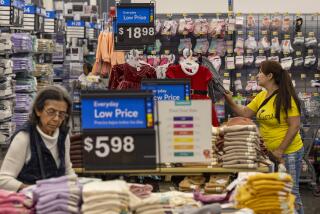Safeway Posts a Profit, but It Feels the Pinch From Bargain-Hungry Shoppers
- Share via
Supermarket giant Safeway Inc. posted a first-quarter profit Thursday after recording a loss a year ago, the company said, but rising expenses and sluggish sales pushed down operating results 40%.
The Pleasanton, Calif., chain, which owns 1,694 stores, including Vons and Pavilions stores in Southern California, has seen its sales slacken as consumers have tightened their belts and spent less, which has put a strain on profit margins. At the same time, the company’s employee health-care and pension costs have escalated.
Safeway, the nation’s third-largest grocer, behind Kroger Co. and Albertson’s Inc., posted income from continuing operations of $196.2 million, or 44 cents a share, in the three months ended March 22.
That was in line with its revised forecast, which it lowered last month, and compared with operating income of $325 million, or 66 cents, in the same period last year.
Although most of the nation’s supermarkets are struggling, Safeway has had a particularly tough time, fumbling in its attempts to integrate acquisitions including the Dominick’s Supermarket chain in the Chicago area. Safeway has since put Dominicks up for sale.
Safeway also has racked up higher-than-expected costs from its centralized buying and advertising system.
Net income for the quarter was $162.6 million, or 36 cents a share, contrasted with a loss of $367.9 million, or 74 cents, in the same period last year. The year-earlier results included a $700-million charge for an accounting change.
In the just-completed quarter, Safeway listed the 116-store Dominick’s chain as “discontinued operations.”
“Safeway did an excellent job when the economy was strong and people were buying at higher price points,” said Charles Cerankosky, an analyst with McDonald Investments, which has no direct banking relationship with Safeway and owns none of its shares. Consumers “are more price-sensitive” and aren’t buying “$30 bottles of wine,” he said. .
Safeway and its rivals have been discounting merchandise aggressively to lure back customers who have gravitated in recent years to such discount retailers as Wal-Mart Stores Inc. and Costco Wholesale Corp. for their food purchases.
But in Safeway’s case, the bargains have done little to generate additional sales.
Total revenue for the quarter inched up to $7.5 billion from $7.4 billion, boosted by the opening of nine stores.
Sales at stores open at least a year -- a key measure of growth -- fell 0.5% in the first quarter from the same period last year, but were an improvement from the fourth quarter, in which they slipped 1.9%.
That prompted Chairman and Chief Executive Steve Burd to announce that the supermarket operator had “hit bottom” and was on its way to greater profitability. “It is a near across-the-board improvement” from the fourth quarter, Burd said.
In a conference call, Safeway forecast earnings of 47 cents to 49 cents a share for the second quarter, below analysts’ expectations of 51 cents. The company earned 63 cents a share in the year-earlier period. However, the company said it would hit its earnings target of $2.20 to $2.25 a share for the year.
The forecast boosted shares $1.26, or nearly 8%, to close at $17.88, one of the biggest gains of the day on the New York Stock Exchange.
Safeway’s shares have lost 60% of their value from their 52-week high a year ago, prompting speculation of a leveraged buyout or stock buyback.
Burd dismissed such notions, saying such a move would force the company to take on more debt and threaten its credit rating.
“We think this is not the best time in the world to leverage up, but a good time to leverage down,” Burd said.
Analysts say the company must iron out the kinks in its new centralized buying and advertising system to boost gross profit, which had dropped to 29.8% of sales in the quarter from 31.4% last year. “Lack of coordination” during the transition to the system caused the company to spend more than it had anticipated, said Melissa Plaisance, Safeway’s senior vice president of finance.
In the next three years, Safeway expects the system to save $600 million in operating expenses.
But in the short term, analysts said, the supermarket operator must find a buyer for its troubled Dominick’s chain, which it acquired in 1998 for $1.2 billion plus debt.
The 116-store chain lost $4.4 million from operations in the first quarter. And the company said Thursday that it expects to take a $302.7-million loss on the sale. A buyer has not yet been identified.
With Wal-Mart planning a major foray into Safeway’s key West Coast markets this year, the grocery chain must become more savvy at luring bargain-hungry shoppers.
“They need a little help from the economy and ... to continue to go after the price-sensitive customers,” said analyst Cerankosky.
More to Read
Inside the business of entertainment
The Wide Shot brings you news, analysis and insights on everything from streaming wars to production — and what it all means for the future.
You may occasionally receive promotional content from the Los Angeles Times.










